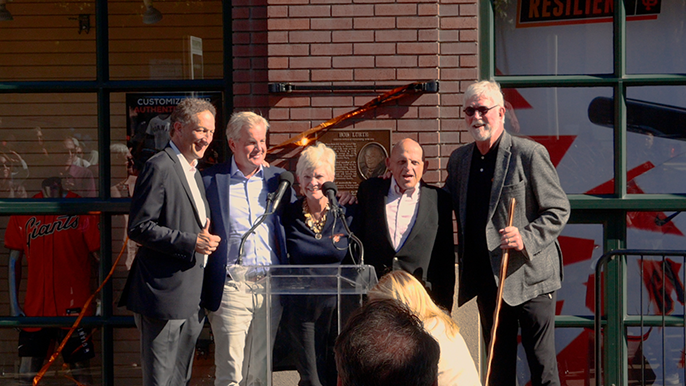Before the Giants game against the Atlanta Braves on Saturday, San Francisco royalty gathered outside Oracle Park to honor a man who last owned the team in 1993.
Former Giants Vida Blue, Will Clark, Jeffrey Leonard, Dave Dravecky, and Kevin Mitchell had front-row seats during the ceremony. Senator Dianne Feinstein, three former San Francisco mayors, former secretary of state Condoleeza Rice and current Giants manager Gabe Kapler were also in attendance. Former coworkers, teammates and family members hugged, kissed and shook hands.
They watched as Bob Lurie became the 54th “Forever Giant,” his likeness now enshrined on the outside of Oracle Park forever. Lurie’s the second non-player ever honored on the Wall of Fame. His legacy is a reminder that history isn’t ancient — that the Giants of today are a product of his actions decades ago.
Lurie, 92, is most known for his role in keeping the franchise in San Francisco. When he put together an ownership group in 1976, the Giants had been sold to Labatt Brewing Company; the team was moving to Toronto until Lurie stepped in.
He inherited an organization out of money and running on fumes. It had recently traded Willie Mays to the New York Mets for cash. They needed it. Lurie had to rebuild every aspect of the organization up from scratch. Under Lurie’s direction, the team became a contender, making the 1989 World Series.
Mike Krukow says his time on other teams was special, but it was the Giants that really made him feel like family. He thanks today’s Wall of Fame inductee, Bob Lurie, for that. pic.twitter.com/uCzz5czK0L
— KNBR (@KNBR) September 19, 2021
Although that feat alone would cement anyone in franchise lore, his impact extends further. Lurie was instrumental in hiring Frank Robinson, the first Black manager in National League history. He and his wife received death threats at the time.
“Bob became a model steward of this franchise,” Giants CEO and president Larry Baer said. “Always trying to do what was best for the fans on and off the field.”
Former Giants executive Corey Busch recalled Lurie’s role in reversing Willie Mays’ post-career ban from baseball because of his involvement with casinos.
For some more subtle reasons, Lurie’s legacy remains omnipresent with the franchise today.
For one, Lurie hired Larry Baer, now the Giants CEO and president, as an intern when he was studying at Cal Berkeley. He also established the Giants Community Fund, which has raised over $34 million to date. By starting the regional sports network that became NBC Sports Bay Area, he gave way to the broadcasting careers of Mike Krukow and Duane Kuiper — the voices of the Giants for the most iconic moments of the franchise’s history.
Plus, in the late 1980s, Lurie led a proposal that would’ve moved the Giants’ home from Candlestick Park to the corner of 3rd and King Street — where Oracle Park stands now. He joked with then-mayor Art Agnos that the park would be so close to the bay that he imagined home run balls flying into the water.
Splash hits, he called them.
Legendary owner Bob Lurie was inducted to the Giants Wall of Fame today. Here’s some highlights from his surprisingly funny acceptance speech. ? pic.twitter.com/M0k1d1FDPh
— KNBR (@KNBR) September 19, 2021
More relics of Lurie’s career with the Giants remain. Ron Wotus, the longest-tenured coach in the organization, had his checks signed by Lurie when playing for the 1989 pennant-winning team. Former mayor Art Agnos invoked Alyssa Nakken — the first-ever full-time woman MLB coach — as an example of the franchise following Lurie’s progressive lead.
After 40 minutes of glowing testimonials from Baer, Busch, Krukow and Agnos, Lurie took the podium to unveil his plaque. He said those were the best speeches he’d ever heard. As chairman Greg Johnson unveiled Lurie’s new plaque, confetti blew into the San Francisco sky.
Without Lurie, not only are the Giants dislocated to some far away city, the Giants aren’t the Giants.
“I think Bob’s body of work exemplifies what legacies are made of,” Busch said. “And his legacy will live forever not just because he’s going to be enshrined in the Giants Wall of Fame, but because of what he did for the Giants, for baseball and for the city he loves.”


